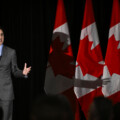Welcome to The Hub’s Federal Election 2021 Policy Pulse, where we’ll be tracking all the policy announcements from the major parties, with instant analysis from our crew of experts.
With the election scheduled for Sept. 20, we’ll be monitoring 36 days worth of policy ideas, so watch out each morning for the day’s live blog where we’ll be tracking every announcement as it happens.
6:00 p.m. — Daily recap: O’Toole unveils a new wage subsidy program
The Tories announced a new wage subsidy program and the Liberals unveiled a plan to give paid sick leave to federally-regulated employees. Here’s the rundown, with more news and analysis below.
- Conservative leader Erin O’Toole highlighted the “job surge plan” from his party’s platform, which would fund up to 50 percent of the salary of new hires for six months.
- Liberal leader Justin Trudeau promised to grant 10 days of paid sick leave for all federally-regulated workers and to convene a meeting with the provinces to discuss paid sick leave for all Canadian workers.
4:00 p.m. — All this talk of housing on the campaign trail, but no mention of quality of life
The Hub contributor Howard Anglin notes that the word “beauty” is missing from all these housing announcements:
Both the NDP and the Conservatives have been talking about housing prices on the campaign trail, with the NDP promising to build 500,000 new “units” and the Conservatives promising one million new homes.
Amid all this talk about quantity of new houses, there is no mention by either party of quality of life in the neighbourhoods and communities they want to build. At least the Conservatives want to build homes, and not “units,” whatever those are.
If we go by recent Canadian house-building trends, it will mean the same two-pronged approach to urban development: forests of identical condo-towers downtown and ugly tract housing sprawling into the farmland and greenbelts around our cities.
What is missing in this is any thought for the built environment. Why must we build such ugly buildings? The middle-class housing of 120 years ago in New York and London is now the highly-desirable brownstones and terrace housing. We see something similar in Montreal in the attractive streets of the Plateau and Outremont.
Is our goal just a bigger Canada or a better life for Canadians? It sometimes feels like we are being ruled by property developers rather than politicians.
If we are going to keep growing our cities inexorably upwards and outwards as fast as possible (which we don’t have to do), can we at least build liveable neighbourhoods? It is possible. In the 1990s, Calgary turned a former CAF base close to downtown into Garrison Woods, a pleasant community of town houses, parks, and local shopping.
Why did not one party use the world “beautiful” in their announcements about new builds? Attractive houses on streets that encourage community interaction, where you would be happy to let your children play, near local shopping that you don’t always have to drive to, should be the default expectation.
The U.K. recently announced a plan to make all new neighbourhoods and housing beautiful. We’ll see if it proves realistic, but at least their government is talking about it.
3:00 p.m. — The Conservative wage subsidy could be more than the economy needs
Aaron Wudrick, the director of domestic policy program at the Macdonald-Laurier Institute, weighs up the Conservative wage subsidy plan:
The Canada Job Surge Plan, proposed by the Conservative Party, could be useful to incentivize employment. With Canada’s unemployment rate currently at 7.8 percent, significantly elevated when compared to pre-pandemic levels, this is a legitimate policy concern. Notably, however, this proposal would principally benefit businesses rather than households, which fills a persistent policy gap that ongoing economic relief has failed to meaningfully address.
That said, with economic indicators already pointing to a solid recovery and with unemployment on a downward trajectory, it is not clear that further stimulus is necessary. Additional stimulus risks raising demand above what the economy can supply without fuelling higher prices. We may already be seeing this with worryingly high inflation – and there is reason to believe that current inflation estimates are not fully capturing actual inflation in Canada.
Finally, with public debt at unsustainable levels, this policy has the potential to be yet another unsustainable expense. While it may seem useful in the short term, the costs of this idea will be borne by Canadians in the form of greater potential inflationary pressure and by future generations in the form of relatively higher taxes or lower spending in public services.
2:15 p.m. — How many workers qualify for the Liberal paid sick leave proposal?
The Hub’s content editor L. Graeme Smith crunches the numbers on the Liberal announcement this morning:
The Liberals want to make it easier for those who are sick to stay home, announcing today a promise to grant 10 days of paid sick leave for all federally-regulated workers. They also plan to convene a meeting with the provinces to discuss implementation of similar policies for provincially-regulated employees as well.
How much of a ripple will this promise actually make? Perhaps not much. This is a policy whose general application is largely out of the government’s hands — that’s why the Liberals will need to sit down and work with the provinces if this is to be extended to most workers in Canada.
Why? Because the vast majority of Canadian workers’ do not fall under federal domain. About 94 percent, in fact, fall under provincial law and jurisdiction. The federally-regulated private sector employs about 910,000 employees across Canada who work for about 18,000 federally regulated businesses and industries.
Ultimately, then, only about six percent of the workforce would immediately qualify for the benefit as Justin Trudeau has laid it out. Any meaningful implementation beyond that is out of his hands and depends on how much the premiers are willing to cooperate with his plans.
1:30 p.m. — O’Toole’s wage subsidy could help offset biases against hiring the long-term unemployed
The Hub’s editor-at-large Sean Speer takes a deeper look at the Conservative wage subsidy program announced today:
Today Conservative leader Erin O’Toole profiled the party’s plan to boost post-pandemic hiring with a temporary wage subsidy that’s based on a new hire’s unemployment duration.
The sliding subsidy starts at 25 percent for every new hire’s salary (up to a maximum salary of $1,129 per week) and can be as generous as 50 percent for employees who have been unemployed for ten months or longer.
The proposal is premised on two policy concerns. The first is that while pandemic-induced employment losses have been reduced in recent months, there’s still about 246,000 fewer Canadians working than in February 2020 (see graph below). It may be that even as the economy fully reopens the labour market operates below pre-pandemic employment levels due to ongoing uncertainty. The wage subsidy could therefore help to nudge employers to hire new workers and in turn close the employment gap.

The second reason is that long-term unemployment currently accounts for 27.8 percent of Canada’s total unemployment. Long-term unemployment is defined as those who have been searching for work or on temporary layoff for 27 weeks or more.
This cohort ought to be a concern for policymakers because there’s considerable evidence that long-term unemployment can have significant effects on individuals and families — including one’s ability to reattach him or herself to the labour market.
These effects are a result of a combination of what’s sometimes called a “depreciation of human capital” (which basically refers to the erosion of one’s skills through lack of use) and a loss of social capital (which refers to the network of contacts and relationships that come from employment).
The idea of a sliding subsidy may help to offset biases that employers may have to hire someone who has been long-term unemployed.
The outstanding questions about the Conservative plan are: (1) whether generous wage subsidies are indeed necessary to close the pandemic-induced employment gap and (2) the implementation of the wage subsidy including the potential for gaming by employers.
But in theory the Conservative “Job Surge Plan” should encourage hiring and in so doing help unemployed Canadians get reattached to paid work.
12:00 p.m. — Policy deep dive: Why good policy on innovation would have to ruffle some feathers
The Hub contributor Matt Spoke goes deep on the Conservative plan to juice innovation in Canada:
Last week, before the election campaign kicked off, Conservative leader Erin O’Toole announced his strategy for Canadian innovation. I’m glad to see this topic addressed, but I don’t think they’re taking their proposals far enough, and I think that they continue to suffer from what other governments and parties fall victim to as well.
Namely, politicians think of innovation as a sector of our economy, or worse, as a cute pastime for hoodie-wearing millennials hanging out in government-subsidized startup incubators.
Here are the big takeaways from O’Toole’s plan, and my thoughts on what they should be doing.
- Reducing the income tax rate by 50 percent on patented technologies being developed and commercialized in Canada, by Canadian companies.
You won’t find me arguing against a tax reduction on startups, but the condition tying this incentive to patented technologies only shows the lack of depth our politicians have when it comes to modern tech. Patents are not what they used to be, particularly in the fastest growing segments of our tech industries building modern software.
This framing of the policy likely benefits incumbents at the cost of new entrants, which is a common theme in most existing government innovation programs.
It also does nothing for Canadian companies with global aspirations, as their revenues will be taxed in the markets that they sell their products and services in. - Introducing flow-through shares as a tax incentive mechanism to encourage investment in innovative companies.
Although there may be some merit to this policy, there are a lot of nuances that make technology companies different from junior mining firms (where flow-through shares were originally introduced).
Instead of creating new complex tax deduction rules for investors, why not simply revisit the capital gains treatment of investments directed to certain types of early-stage innovative businesses? - Stopping government funding of foreign-owned technologies and companies; namely: Huawei.
Of course, the Canadian Federal Government should not be subsidizing Chinese state-owned research and development. On this policy, the devil will be in the details.
Already today, many of our innovation-focused government incentives are tied to CCPC rules (Canadian Controlled Private Corporations), which in principle sound positive, but in practice constrain world-class Canadian entrepreneurs from raising significant sums of capital from more established venture capital markets like the U.S.
You don’t have to look much farther than home-grown Shopify. Their success, although a Canadian story, was fuelled heavily by U.S. investment dollars. We should celebrate this, not seek to discourage it. - Fixing the SR&ED program by simplifying the application process and moving it to another government department.
Any Canadian entrepreneur who has dealt with SR&ED will agree that this program is completely broken. I would argue, irreparably.
Although I agree that it’s laughable that our #1 government incentive program for innovation is managed by the CRA, I don’t think the solution is to transfer it to a different government department.
SR&ED is a political third rail, but ultimately it needs to be unwound. The billions of dollars we spend on it every year have no measurable impact on our economic growth, other than having spurred an industry of specialized “form-filling” consultants.
We should redirect those billions of dollars to a new sovereign wealth fund focused on investing in technology businesses, and operated at arm’s length from any bureaucracy in Ottawa. Singapore has found meaningful success with this model through Temasek; which has now become a globally renowned tech investor. - Addressing the “brain drain.”
Although O’Toole made mention of the fact that we see a large number of our STEM graduates moving to the U.S. to pursue opportunity, he didn’t specifically address how we might solve this.
The proposed policies above will have a part to play in creating a more attractive market in Canada, but ultimately we could be more precise with addressing our brain drain problem.
The University of Waterloo, for example, sees more than 50 percent of its graduating software engineers move to the U.S., after having received four years of heavily subsidized Canadian post-secondary education.
A brain drain policy would revisit our education funding to post-secondary students, such that it ties any subsidy to a condition of working or building a business in Canada post graduation. Simply put, if a Waterloo engineer wants to move to Silicon Valley, they should reimburse the federal government for the subsidized portion of their prior 4 years of tuition.
I’m encouraged by O’Toole prioritizing this topic leading up to an election. We’re past due for some public debate on why we continuously fail on innovation compared to our peers.
That said, it’s critical that we approach this through the right frame. Innovation is not a separate topic from economic growth. Innovation should be how we think of all economic policy. If we are not encouraging more global competitiveness and productivity within our industries, we will continue to fall behind others who do.
The focus should also not be on jobs. Jobs will be a result of intelligent economic policy focused on growth.
Our politicians should be asking questions like “how do we create an economy that regularly generates 5 percent GDP growth annually?” We need bold thinking to address this.
“Why are our largest businesses (with the exception of Shopify and maybe Lululemon) all incumbents who primarily only operate in Canada?”
“How do we help create a class of new companies that have global aspirations and technology at the centre of their businesses?”
The party that thinks this way, and is not scared to ruffle some incumbent feathers along the way, has my vote.
11:00 a.m. — O’Toole announces subsidy program for new hires
Conservative leader Erin O’Toole was in Winnipeg this morning to announce a new subsidy he says will create jobs in post-pandemic Canada.
O’Toole highlighted the “job surge plan” from his party’s platform, which would fund up to 50 percent of the salary of new hires for six months. The program would begin after the current wage subsidy ends in the fall.
The job subsidy starts at 25 percent and scales up based on how long the new employee was unemployed before being hired.
10:00 a.m. — Trudeau promises paid sick leave for federal employees and more money for ventilation
Liberal leader Justin Trudeau was in Winnipeg to highlight a proposal for paid sick leave for federal employees.
The Liberal leader promised to grant 10 days of paid sick leave for all federally-regulated workers and to convene a meeting with the provinces to discuss paid sick leave for all Canadian workers.
Trudeau also promised tax credits for businesses to upgrade ventilation, including HEPA filters, and funding of $100 million to improve common spaces like libraries and gyms.
7:00 a.m. — The daily agenda for Day 6
Liberal leader Justin Trudeau will be in Winnipeg to make an announcement at 8:45 a.m. local time (9:45 a.m. ET).
Conservative leader Erin O’Toole will be in Winnipeg at 10 a.m. local time (11 a.m. ET) to make an announcement.
NDP leader Jagmeet Singh will be in Saskatchewan to make an announcement at 11 a.m. local time (1 p.m. ET).
Recommended for You

The Notebook by Theo Argitis: Carney’s One Big Beautiful Tax Cut, and fresh budget lessons from the U.K.

Ginny Roth: How vacant liberal nationalism left Canada worse off than George Grant even imagined

Peter Menzies: Justin Trudeau’s legislative legacy is still haunting the Liberals

‘Our role is to ask uncomfortable questions’: The Full Press on why transgender issues are the third rail of Canadian journalism



